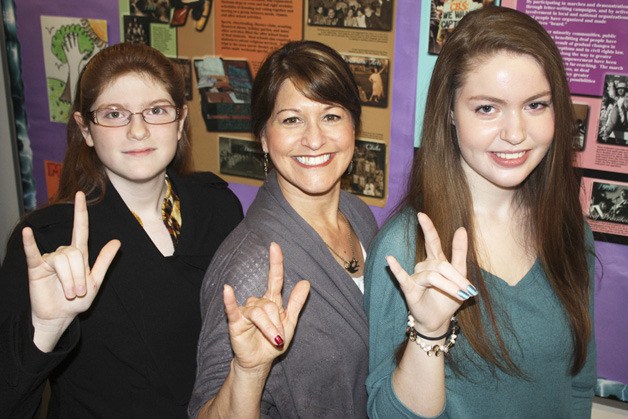Sign language opens a different, engaging channel of communication for Jessica Fletcher.
Her mother, Colleen, is technically hard of hearing, and frequently she turns to her wide vocabulary of hand-shaped signs to exchange a silent, captivating conversation.
“I mean, my mom is completely oral. She hears, but she needs to lipread,” said Fletcher, a junior at Auburn Riverside High School and a second-year student in Cindy Anderson’s American Sign Language (ASL) class. “My mom used to work with deaf people sometimes, so I thought it would be interesting to learn the language.
“There are new signs I picked up from what my mom remembered, and I knew the entire alphabet,” she added. “It’s interesting.”
And worthwhile.
Fletcher and her classmates continue to excel in Anderson’s program, the only one of its kind offered in the Auburn School District.
Representing Auburn Riverside, Fletcher recently won a statewide contest – Tahoma High School’s ASL Invitational – in the second-year level, storytelling category for her symbolic rendition of “King Kong”.
In front of judges, a majority of whom are deaf, Fletcher successfully translated the story within the three-minute limit.
Asked how she described the star gorilla, a grinning Fletcher simultaneously pumped her closed fists off her chest.
Fletcher’s classmate, Jayme Greer, also stood tall at the invitational, placing third in the ABC storytelling category for second-year level “sign” students. Greer, a junior, used hand-shaped letters – the full alphabet – to spell out the story of “Gone Fishing”.
Greer decided to try sign language, following her sister, Kelsey, who flourished under Anderson’s guidance.
“I like the idea that you don’t have to talk to convey what you’re thinking,” said Greer, an exceptional student who would like to pursue civil engineering at Oregon State University. “It’s really a unique form of language.”
Fletcher and Greer are exemplary personalities of Anderson’s work. Anderson, who previously worked as a silent language interpreter before going into teaching, offers five classes daily, working with about 140 students of varying skill levels. Anderson is in her 16th year at the school.
“Some students can just memorize signs quickly and just grasp the whole concept of ASL as a different language, and the grammar part that comes with the language as well,” Anderson said. “These two (Fletcher and Greer) definitely learned quickly. They retained the information and they can produce the language, not just watch it and understand it.”
Students, such as Fletcher and Greer, learn at least 500 signs by the second year.
Fletcher’s favorite? The sign for “how are you?”
Greer’s? The expression for “trouble.”
Like Greer, Fletcher hopes to practice conversational ASL long after she finishes school.
Students often become fluent with the alphabet, but encounter some difficulty in learning the different sentence structures. ASL follows the same English order, others do not, Anderson said.
While ASL is the native language of most deaf and hard-of-hearing people in the country, not all signs are interpreted similarly. Distinct signs or accents are practiced in different regions, Anderson said.
Despite its challenges – like other foreign languages – ASL gradually has caught on in acceptance and exposure, Anderson said.
“It was considered a true foreign language since the 1960s. It has taken many years for colleges and universities to accept it as a true foreign language,” she said.
That acceptance has led to high schools offering the program.
Many colleges and universities are beginning to recognize the study of ASL and deaf culture as legitimate academic pursuits, and are starting to accept ASL in fulfillment of their foreign language entrance and exit requirements.
In several states, including Washington, ASL is mandated by law as acceptable in fulfillment of high school foreign language graduation requirements.
More and more colleges and universities are accepting ASL in fulfillment of foreign language requirements.
“ASL has come far, and improved in many ways (in the classroom) today,” Anderson said.


